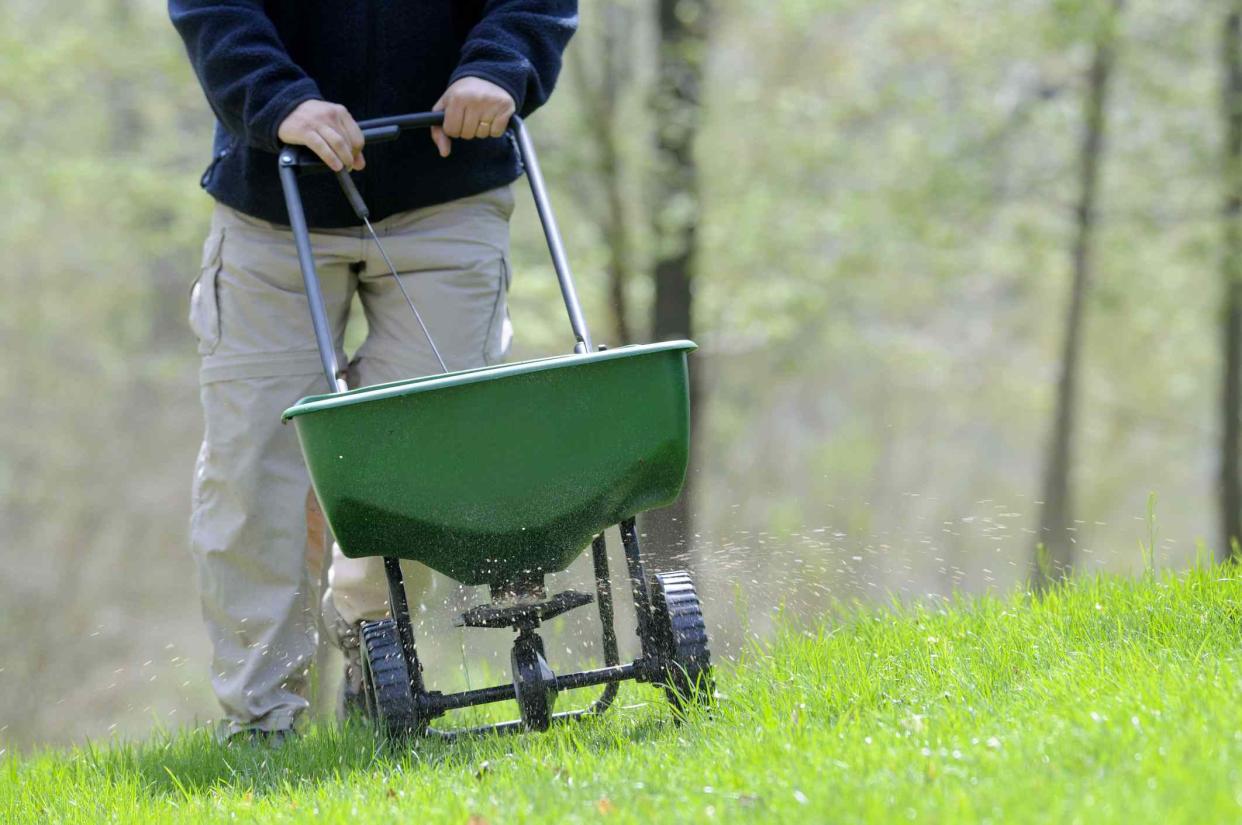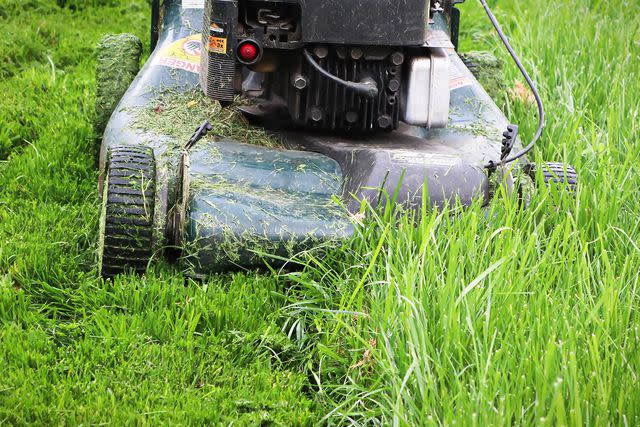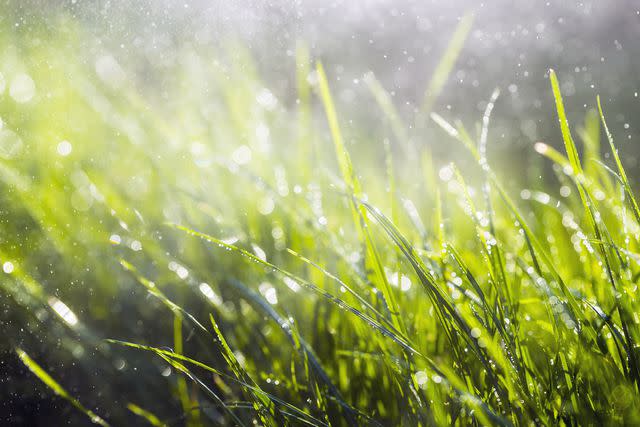How Often Should You Fertilize Your Lawn?

groveb / Getty Images
Reviewed by Amanda Rose Newton
The short answer to the question of how often to fertilize your lawn is that it depends on several factors, including the type of fertilizer and how much is applied, the type of turfgrass, soil texture, nutrient level, and more. Generally speaking, most homeowners will fertilize their lawn at least twice per year. To determine when to apply fertilizer to your lawn, you need to take a holistic approach and consider all of these factors together.
Why Fertilization Is Important
Lawn fertilizers are made of three major nutrients: nitrogen (N), phosphorous (P), and potassium (K). These are formulated in various combinations and concentrations. Because nitrogen is the key nutrient for leaf growth, the ratio of nitrogen in lawn fertilizer is always the highest. Phosphorus is important for root growth, and potassium helps with water and nutrient absorption, but their numbers are always lower because most soils already contain enough or most of those two nutrients.
The 9 Best Fertilizers of 2024
How Much and Which Fertilizer to Use
Lawn fertilizers fall into three categories: granular slow-release, liquid water-soluble, organic, and synthetic. In most cases, granular slow-release fertilizer is the best to use because it slowly feeds and releases nitrogen into the grass over a period of months.
When fertilizing the lawn, it's best to use no more than one pound of nitrogen per 1,000 square feet at a time. How this translates into the exact fertilizer amount depends on the percentage of nitrogen in the fertilizer. If you use a fertilizer with a high percentage of nitrogen, such as 30-0-4, you will need less fertilizer than when using a 24-0-5 fertilizer. Always follow the directions on the fertilizer label.
The only way to know for sure how much fertilizer your lawn needs is to do a soil test in a specialized laboratory (you can get it from your local Extension Office). Everything else is mere guesswork and overdoing the fertilizer can be more detrimental to the lawn than using no fertilizer at all. While you can fix an overfertilized lawn, in the absence of a soil test, being a minimalist is the safest approach to avoid problems in the first place.
Low-Maintenance vs. High-Maintenance Lawn
The key question is what type of lawn you are after, and how much time and money you are willing to spend. For a manicured, picture-perfect lawn, or turfgrass that needs to withstand high traffic or use, applying a conventional synthetic lawn fertilizer at regular intervals is usually in order. If you are OK with a more natural looking, low-maintenance lawn, you can use organic fertilizer, rely on nitrogen from mulched grass clippings to feed the lawn, and be more relaxed about the frequency of applications.
Tip
No matter what you want your lawn to look like, it always needs a good start. For newly seeded lawn, a turf-builder application, also called a starter fertilizer, is crucial so the grass can develop strong root systems.

Akchamczuk / Getty Images
Leaving grass clippings on the lawns adds nitrogenWarm-Season vs. Cool-Season
The frequency and timing of fertilization depends on the type of grass.
Cool-Season Grasses
Kentucky bluegrass, perennial ryegrass, fine fescue, and tall fescue are cool-season grasses for northern climates. They grow the most during cool weather in the spring and fall. These grasses are usually fertilized twice a year.
In the spring, after the cool-season grasses break their winter dormancy, give the grass until the late spring to grow and build its carbohydrate reserves. Apply slow-release fertilizer before the summer heat sets in.
In the summer, cool-season grasses go into survival mode and fertilizing then is wasteful, harmful, and damages the grass.
The second fertilization should be in the late summer or early to mid-fall. Unlike the spring application, which is meant to boost vigorous leaf growth, the fall fertilization is done to strengthen the root system. Time it early enough so the grass has still several weeks of active growth before hard frost starts its dormancy. This fall application might make it unnecessary to fertilize the following spring but again, only a soil test will tell you if your lawn needs fertilization and how much.
Warm-Season Grasses
Warm-season grasses—bermudagrass, buffalograss, centipedegrass, St. Augustine grass, and zoysia grass—grow most actively in warm weather. Just as cool-season grasses, they are usually fertilized twice a year, but the timing is slightly different.
The first fertilizer application should be about six weeks after the last spring frost when the grass has turned green, and you have already mowed it at least twice.
The second fertilization should be in the late summer or early fall, which does two things: it replenishes the energy reserves of the grass that were depleted when the grass worked on surviving the summer, and it winterizes the grass by making it grow denser so winter weeds, which are present in warm climates, get less of a chance to establish themselves. For the second fertilization, a soluble, readily available nitrogen fertilizer is often recommended.
Only in warmer locations with even longer growing seasons, a third light nitrogen application may be advised to keep the grass growing over the fall and winter. Wait at least 45 to 60 days between applications.
When Is the Best Time to Fertilize?
Besides the season when you fertilize, the time of the day is also important. Fertilize in the morning when it is still cool and the grass is slightly damp from the dew but not wet. The grass must be dry enough when you apply the fertilizer that the granules will fall between the blades of grass and onto the soil and won't cling to the blades, otherwise it can lead to fertilizer burn.
Keep an eye on the weather forecast, because the fertilizer should be watered in within a day or two of application. Fertilize before it rains, ideally a slow and steady rainfall and not an intense rainstorm, which will wash the fertilizer away and it will end up in storm drains and streams and pollute waterways. The alternative to rain is to water the lawn with at least a quarter inch of water after the fertilizer application.

Image by Chris Winsor
Fertilize before it rainsSet a Lawn Fertilizing Schedule
Creating a lawn fertilizing schedule is a good idea to keep track of when you fertilize and how much. It also helps you to get everything lined up in time for fertilization.
However, lawn fertilizing schedule needs to be flexible. If rain is not in the forecast, delay fertilizing until it is. And if there is a drought, delay the fertilization until it’s over, or skip it altogether. When there is no water, grass won’t grow, and fertilizer has no place to go. Fertilizing a lawn during a drought when the grass is already stressed makes fertilizer burns more likely.
Frequently Asked Questions
How do you know if you have overfertilized your lawn?
If you think your lawn is suffering from too much fertilization, check for signs such as patchy or overall excessive growth, sudden pest infestations, new weeds, and fertilizer buildup or runoff.
Can I fertilize my lawn only once per year?
You can only fertilize once per year and still maintain a healthy lawn. The best time to do this would be in the fall. Take care to use a high-quality formula with slow-release nitrogen so that your grass reaps the benefits all the way into spring.
What will happen if I don't fertilize my lawn every year?
Depending on how rich the soil is in your region, not fertilizing at all can leave your lawn deficient in nutrients. This results in vulnerability to pests, diseases, and weeds. You may experience patches of thinning, weak grass that eventually turns brown.
Read the original article on The Spruce.

